太阳能电池光电转换效率汇总
- 格式:pdf
- 大小:95.42 KB
- 文档页数:7

一文看懂光电转化效率计算方法光电转化效率简介光电转化效率,即入射单色光子-电子转化效率(monochromaticincidentphoton-to-electronconversionefficiency,用缩写IPCE表示),定义为单位时间内外电路中产生的电子数Ne与单位时间内的入射单色光子数Np之比。
光电转化效率的公式从电流产生的过程考虑,IPCE与光捕获效率(lightharvestingefficiency)LHE(l)、电子注入量子效率finj及注入电子在纳米晶膜与导电玻璃的后接触面(backcontact)上的收集效率fc三部分相关。
见公式:IPCE(l)=LHE(l)′finj′fc=LHE(l)′f(l)其中finj′fc可以看作量子效率f(l)。
由于0£LHE(l)£1,所以对于同一体系,IPCE (l)£f(l)。
两者相比,IPCE(l)能更好地表示电池对太阳光的利用程度,因为f(l)只考虑了被吸收光的光电转化,而IPCE(l)既考虑了被吸收光的光电转化又考虑了光的吸收程度。
譬如,若某电极的光捕获效率为1%,而实验测得量子效率f(l)为90%,但其IPCE(l)只有0.9%。
作为太阳能电池,必须考虑所有入射光的利用,所以用IPCE(l)表示其光电转化效率更合理;作为LB膜或自组装膜敏化平板电极的研究主要用来筛选染料而不太注重光捕获效率,所以常用f(l)表示光电转化效果。
在染料敏化太阳能电池中,IPCE(l)与入射光波长之间的关系曲线为光电流工作谱。
太阳能电池板转换效率计算公式光照强度—以AM1.5为标准,即1000W/m2暗电流比例—Irev》6电池片所占比例低效片比例—P156Eff《14.5%电池片所占比例太阳能电池片功率计算公式电池片制造商在产品规格表中会给出标准测试条件下的太阳电池性能参数:一般包括有短路电流Isc;开路电压V oc;最大功率点电压Vap;最大功率点电流Iap;最大功率Pmpp;转换效率Eff等。
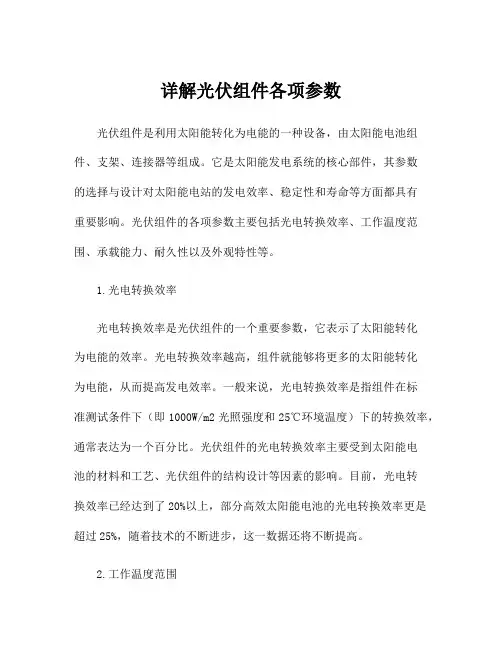
详解光伏组件各项参数光伏组件是利用太阳能转化为电能的一种设备,由太阳能电池组件、支架、连接器等组成。
它是太阳能发电系统的核心部件,其参数的选择与设计对太阳能电站的发电效率、稳定性和寿命等方面都具有重要影响。
光伏组件的各项参数主要包括光电转换效率、工作温度范围、承载能力、耐久性以及外观特性等。
1.光电转换效率光电转换效率是光伏组件的一个重要参数,它表示了太阳能转化为电能的效率。
光电转换效率越高,组件就能够将更多的太阳能转化为电能,从而提高发电效率。
一般来说,光电转换效率是指组件在标准测试条件下(即1000W/m2光照强度和25℃环境温度)下的转换效率,通常表达为一个百分比。
光伏组件的光电转换效率主要受到太阳能电池的材料和工艺、光伏组件的结构设计等因素的影响。
目前,光电转换效率已经达到了20%以上,部分高效太阳能电池的光电转换效率更是超过25%,随着技术的不断进步,这一数据还将不断提高。
2.工作温度范围光伏组件的工作温度范围是指组件在正常运行时,能够承受的最高温度和最低温度范围。
光伏组件在工作时会受到太阳辐射的照射,会产生一定的热量,而在高温环境下,组件的转换效率往往会降低,甚至存在热量致使组件性能下降、寿命减少等问题。
因此,光伏组件的工作温度范围通常在-40℃至85℃之间,同时还需要具备良好的散热性能,以保证组件在高温环境下能够稳定、高效运行。
3.承载能力光伏组件的承载能力主要指组件本身的抗风压、抗雨淋、抗冻融、抗撞击等能力,以及组件安装支架的承载能力。
由于光伏组件安装在室外,需要经受各种自然环境的考验,因此对于其承载能力要求较高。
一般来说,光伏组件的承载能力会通过一系列的测试来验证,如风压测试、雨淋测试、冷热循环测试等。
在实际工程应用中,需要根据当地的气候条件和工程要求来选择适合的光伏组件和支架,以确保太阳能电站的安全、稳定运行。
4.耐久性光伏组件的耐久性是指其在使用过程中能够保持稳定的性能,具备较长的使用寿命。
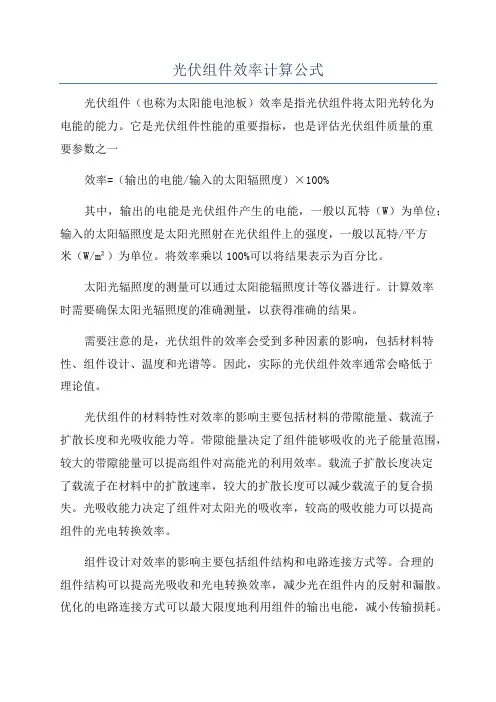
光伏组件效率计算公式光伏组件(也称为太阳能电池板)效率是指光伏组件将太阳光转化为电能的能力。
它是光伏组件性能的重要指标,也是评估光伏组件质量的重要参数之一效率=(输出的电能/输入的太阳辐照度)×100%其中,输出的电能是光伏组件产生的电能,一般以瓦特(W)为单位;输入的太阳辐照度是太阳光照射在光伏组件上的强度,一般以瓦特/平方米(W/m²)为单位。
将效率乘以100%可以将结果表示为百分比。
太阳光辐照度的测量可以通过太阳能辐照度计等仪器进行。
计算效率时需要确保太阳光辐照度的准确测量,以获得准确的结果。
需要注意的是,光伏组件的效率会受到多种因素的影响,包括材料特性、组件设计、温度和光谱等。
因此,实际的光伏组件效率通常会略低于理论值。
光伏组件的材料特性对效率的影响主要包括材料的带隙能量、载流子扩散长度和光吸收能力等。
带隙能量决定了组件能够吸收的光子能量范围,较大的带隙能量可以提高组件对高能光的利用效率。
载流子扩散长度决定了载流子在材料中的扩散速率,较大的扩散长度可以减少载流子的复合损失。
光吸收能力决定了组件对太阳光的吸收率,较高的吸收能力可以提高组件的光电转换效率。
组件设计对效率的影响主要包括组件结构和电路连接方式等。
合理的组件结构可以提高光吸收和光电转换效率,减少光在组件内的反射和漏散。
优化的电路连接方式可以最大限度地利用组件的输出电能,减小传输损耗。
温度对效率的影响主要是由于光伏组件的电性能随温度的变化而改变。
一般情况下,较低的温度有利于组件效率的提高,因为低温可以减小载流子复合损失和电阻损耗。
光谱对效率的影响主要是由于太阳光谱分布的变化。
太阳光谱在可见光范围内具有较高的能量密度,而在紫外光和红外光范围内能量密度较低。
光伏组件通常只能有效地利用可见光范围的光子能量,因此光谱的变化会影响组件效率。
总之,光伏组件效率的计算是一个综合考虑多种因素的过程。
通过合理的材料选择、组件设计、电路连接和温度控制等手段,可以提高光伏组件的效率,从而提高光伏系统的整体性能和经济性。
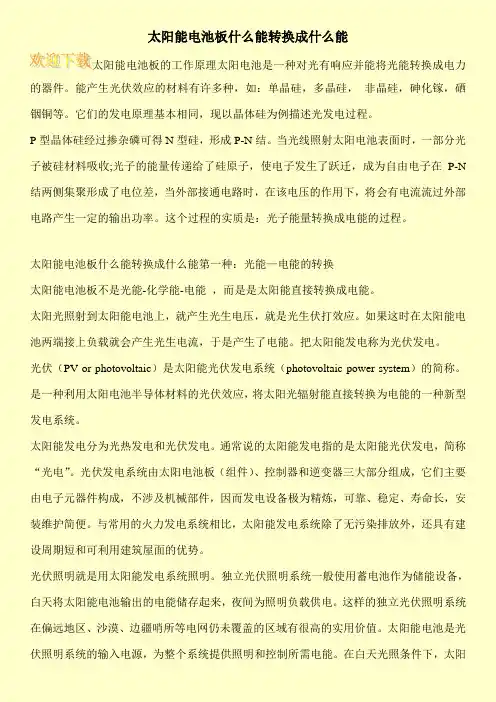
太阳能电池板什么能转换成什么能太阳能电池板的工作原理太阳电池是一种对光有响应并能将光能转换成电力的器件。
能产生光伏效应的材料有许多种,如:单晶硅,多晶硅,非晶硅,砷化镓,硒铟铜等。
它们的发电原理基本相同,现以晶体硅为例描述光发电过程。
P型晶体硅经过掺杂磷可得N型硅,形成P-N结。
当光线照射太阳电池表面时,一部分光子被硅材料吸收;光子的能量传递给了硅原子,使电子发生了跃迁,成为自由电子在P-N 结两侧集聚形成了电位差,当外部接通电路时,在该电压的作用下,将会有电流流过外部电路产生一定的输出功率。
这个过程的实质是:光子能量转换成电能的过程。
太阳能电池板什么能转换成什么能第一种:光能—电能的转换太阳能电池板不是光能-化学能-电能,而是是太阳能直接转换成电能。
太阳光照射到太阳能电池上,就产生光生电压,就是光生伏打效应。
如果这时在太阳能电池两端接上负载就会产生光生电流,于是产生了电能。
把太阳能发电称为光伏发电。
光伏(PV or photovoltaic)是太阳能光伏发电系统(photovoltaic power system)的简称。
是一种利用太阳电池半导体材料的光伏效应,将太阳光辐射能直接转换为电能的一种新型发电系统。
太阳能发电分为光热发电和光伏发电。
通常说的太阳能发电指的是太阳能光伏发电,简称“光电”。
光伏发电系统由太阳电池板(组件)、控制器和逆变器三大部分组成,它们主要由电子元器件构成,不涉及机械部件,因而发电设备极为精炼,可靠、稳定、寿命长,安装维护简便。
与常用的火力发电系统相比,太阳能发电系统除了无污染排放外,还具有建设周期短和可利用建筑屋面的优势。
光伏照明就是用太阳能发电系统照明。
独立光伏照明系统一般使用蓄电池作为储能设备,白天将太阳能电池输出的电能储存起来,夜间为照明负载供电。
这样的独立光伏照明系统在偏远地区、沙漠、边疆哨所等电网仍未覆盖的区域有很高的实用价值。
太阳能电池是光伏照明系统的输入电源,为整个系统提供照明和控制所需电能。
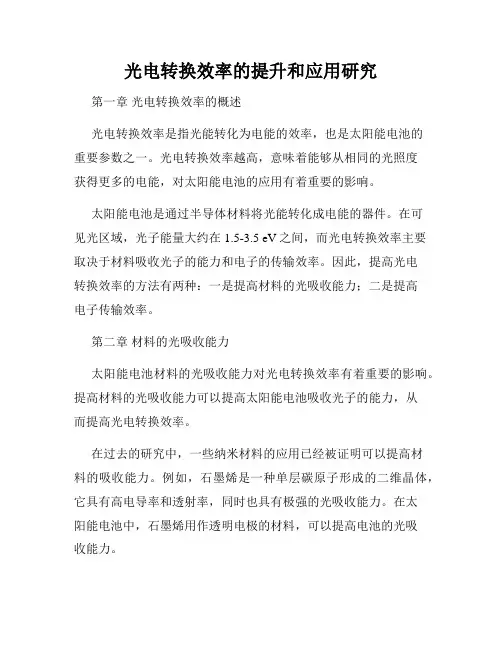
光电转换效率的提升和应用研究第一章光电转换效率的概述光电转换效率是指光能转化为电能的效率,也是太阳能电池的重要参数之一。
光电转换效率越高,意味着能够从相同的光照度获得更多的电能,对太阳能电池的应用有着重要的影响。
太阳能电池是通过半导体材料将光能转化成电能的器件。
在可见光区域,光子能量大约在1.5-3.5 eV之间,而光电转换效率主要取决于材料吸收光子的能力和电子的传输效率。
因此,提高光电转换效率的方法有两种:一是提高材料的光吸收能力;二是提高电子传输效率。
第二章材料的光吸收能力太阳能电池材料的光吸收能力对光电转换效率有着重要的影响。
提高材料的光吸收能力可以提高太阳能电池吸收光子的能力,从而提高光电转换效率。
在过去的研究中,一些纳米材料的应用已经被证明可以提高材料的吸收能力。
例如,石墨烯是一种单层碳原子形成的二维晶体,它具有高电导率和透射率,同时也具有极强的光吸收能力。
在太阳能电池中,石墨烯用作透明电极的材料,可以提高电池的光吸收能力。
一些其他新型半导体材料也被发现具有较高的光吸收能力。
例如,近年来发现的有机无机杂化材料,如锡钙钛矿,因其高的光吸收能力和优异的电荷传输性能而得到广泛的研究。
第三章电子传输效率的提高光电转换效率还取决于电子传输效率。
在太阳能电池中,电子传输效率通常指从吸收光子到电子注入导体之间的效率。
电子的传输效率受到很多因素的影响,包括材料的成分、形貌和表面状态等。
针对这些因素进行改进,提高电子传输效率是提高光电转换效率的重要方法之一。
传统的提高电子传输效率的方法主要是利用微观结构的调整。
例如,通过增加材料的晶粒尺寸和减少界面缺陷可以提高电子传输效率。
最近,人们还探索了一些新的提高电子传输效率的方法,如利用表面等离子体共振增强吸收和发射、控制界面缺陷等。
第四章光电转换效率的应用研究太阳能电池作为一种新型的清洁能源,其能源利用效率和使用方便性也受到了广泛关注。
在未来,太阳能电池的应用将涉及建筑、汽车、电子产品和航空航天等领域。
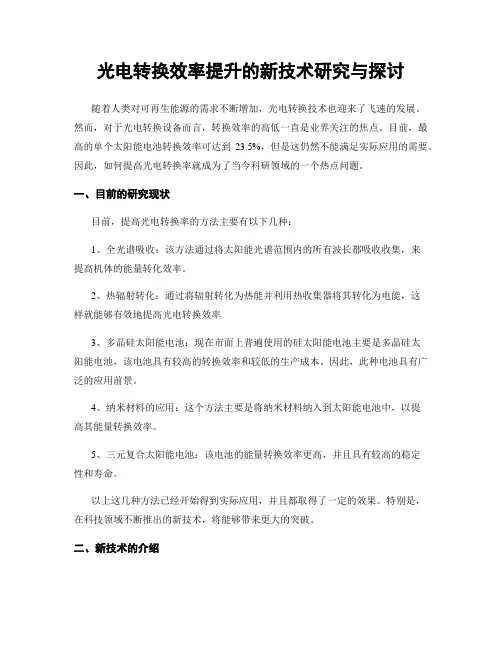
光电转换效率提升的新技术研究与探讨随着人类对可再生能源的需求不断增加,光电转换技术也迎来了飞速的发展。
然而,对于光电转换设备而言,转换效率的高低一直是业界关注的焦点。
目前,最高的单个太阳能电池转换效率可达到23.5%,但是这仍然不能满足实际应用的需要。
因此,如何提高光电转换率就成为了当今科研领域的一个热点问题。
一、目前的研究现状目前,提高光电转换率的方法主要有以下几种:1、全光谱吸收:该方法通过将太阳能光谱范围内的所有波长都吸收收集,来提高机体的能量转化效率。
2、热辐射转化:通过将辐射转化为热能并利用热收集器将其转化为电能,这样就能够有效地提高光电转换效率3、多晶硅太阳能电池:现在市面上普遍使用的硅太阳能电池主要是多晶硅太阳能电池,该电池具有较高的转换效率和较低的生产成本。
因此,此种电池具有广泛的应用前景。
4、纳米材料的应用:这个方法主要是将纳米材料纳入到太阳能电池中,以提高其能量转换效率。
5、三元复合太阳能电池:该电池的能量转换效率更高,并且具有较高的稳定性和寿命。
以上这几种方法已经开始得到实际应用,并且都取得了一定的效果。
特别是,在科技领域不断推出的新技术,将能够带来更大的突破。
二、新技术的介绍由于以上几种研究方法在实际应用中仍存在一定的不足之处。
因此,科研人员不断在尝试新的解决方案。
下面,我们就对目前提升光电转换率的新技术进行简单介绍:1、全球太阳能研究所研究团队开发的AA-MBE技术AA-MBE技术是一种新型的太阳能电池材料集成技术,该技术可利用非准谷材料来直接生长太阳能电池。
与传统的二维材料生长技术不同,AA-MBE技术可以将材料沉积在三维纳米棒表面上,并能够对材料进行精细控制,以实现量子水平的控制和组合。
目前,该技术的转化效率最高可达40.7%,远高于之前的记录。
这项研究成果已经发表在美国《科学》杂志上,并在全球范围内引起了极大的关注。
2、量子点增强技术量子点是一种微小的半导体颗粒,其大小通常在几个纳米到数十个纳米之间。
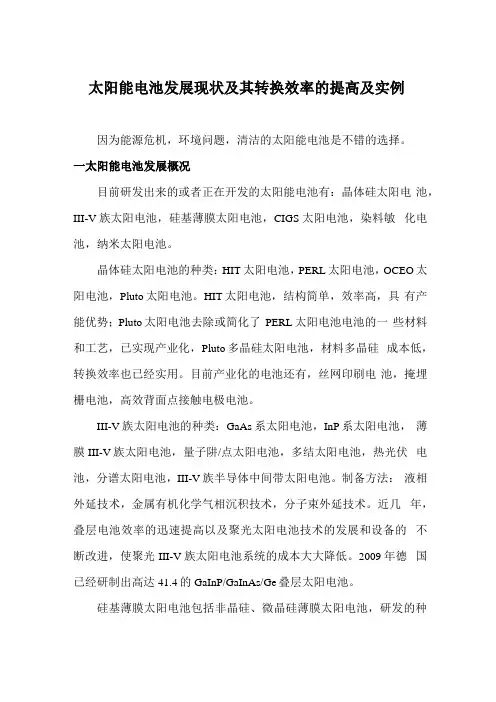
太阳能电池发展现状及其转换效率的提高及实例因为能源危机,环境问题,清洁的太阳能电池是不错的选择。
一太阳能电池发展概况目前研发出来的或者正在开发的太阳能电池有:晶体硅太阳电池,III-V族太阳电池,硅基薄膜太阳电池,CIGS太阳电池,染料敏化电池,纳米太阳电池。
晶体硅太阳电池的种类:HIT太阳电池,PERL太阳电池,OCEO 太阳电池,Pluto太阳电池。
HIT太阳电池,结构简单,效率高,具有产能优势;Pluto太阳电池去除或简化了PERL太阳电池电池的一些材料和工艺,已实现产业化,Pluto多晶硅太阳电池,材料多晶硅成本低,转换效率也已经实用。
目前产业化的电池还有,丝网印刷电池,掩埋栅电池,高效背面点接触电极电池。
III-V族太阳电池的种类:GaAs系太阳电池,InP系太阳电池,薄膜III-V族太阳电池,量子阱/点太阳电池,多结太阳电池,热光伏电池,分谱太阳电池,III-V族半导体中间带太阳电池。
制备方法:液相外延技术,金属有机化学气相沉积技术,分子束外延技术。
近几年,叠层电池效率的迅速提高以及聚光太阳电池技术的发展和设备的不断改进,使聚光III-V族太阳电池系统的成本大大降低。
2009年德国已经研制出高达41.4的GaInP/GaInAs/Ge叠层太阳电池。
硅基薄膜太阳电池包括非晶硅、微晶硅薄膜太阳电池,研发的种类有:a-SiC/a-Si异质结太阳电池,uc-Si薄膜太阳电池,非晶硅/微晶硅串联太阳电池。
制备方法较多,值得关注的新方法有热膨胀等离子体沉积法,常压等离子气相沉积法。
产业化生产技术:以玻璃衬底的硅基薄膜太阳电池制备技术,非晶硅薄膜的柔性衬底、卷到卷太阳电池制备技术。
硅基薄膜太阳电池所需原材料少,可大面积沉积,成本低,可沉积到柔性衬底上,柔性衬底的电池可以装在非平整的建筑物表面上,但转化效率低,仅7.5%-8.5%,非晶硅和非晶锗硅合金电池的光诱导衰退,是需要解决的问题。
CIGS太阳电池研发的有:柔性金属CIGS电池、聚合物衬底CIGS 薄膜电池。
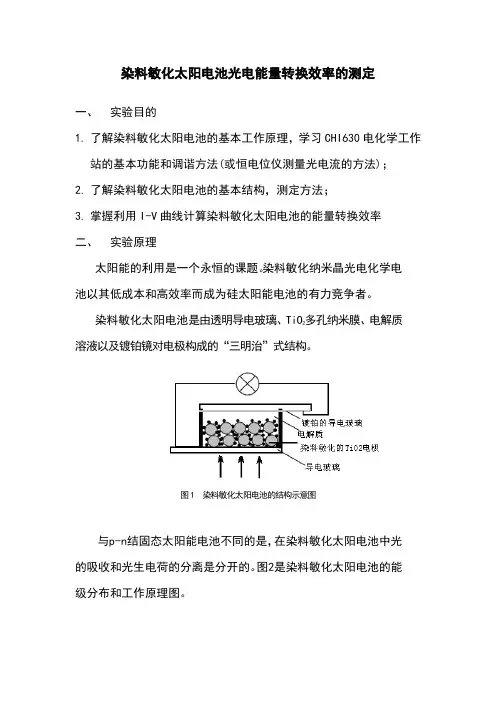
染料敏化太阳电池光电能量转换效率的测定一、实验目的1.了解染料敏化太阳电池的基本工作原理,学习CHI630电化学工作站的基本功能和调谐方法(或恒电位仪测量光电流的方法);2.了解染料敏化太阳电池的基本结构,测定方法;3.掌握利用I-V曲线计算染料敏化太阳电池的能量转换效率二、实验原理太阳能的利用是一个永恒的课题。
染料敏化纳米晶光电化学电池以其低成本和高效率而成为硅太阳能电池的有力竞争者。
染料敏化太阳电池是由透明导电玻璃、TiO2多孔纳米膜、电解质溶液以及镀铂镜对电极构成的“三明治”式结构。
图1 染料敏化太阳电池的结构示意图与p-n结固态太阳能电池不同的是,在染料敏化太阳电池中光的吸收和光生电荷的分离是分开的。
图2是染料敏化太阳电池的能级分布和工作原理图。
图2 染料敏化纳米晶太阳能电池的工作原理Ecb半导体的导带边;Evb半导体的价带边; D’,D’’分别是染料的基态和激发态; I-,I-是氧化还原电解质。
对电极表面镀一层金属铂3上图表示在光照射太阳电池后,电池内的电子直接转移过程。
(1)染料分子的激发。
(2)染料分子中激发态的电子注入到TiO2的导带,CB和VB 分别表示TiO2的导带底和价带顶。
从图中可以看出染料分子的能带最好与TiO2的能带重叠,这有利于电的注入。
(3)染料分子通过接受来自电子供体-I的电子,得以再生。
(4)注入到TiO2导带中的电子与氧化态染料之3间的复合,此过程会减少流入到外电路中电子的数量,降低电池的光电流。
(5)注入到TiO2导带中的电子通过TiO2网格,传输TiO2膜与导电玻璃的接触面后流入到外电路,产生光电流。
(6)在TiO2中传输的电子与-I间3的复合反应。
(7) -I离子扩散到对电极被还原再生,完成外电路中电流循3环。
太阳能电池的性能测试系统主要分为五部分,分别为光源,透镜,电池器件,电化学工作站(恒电位仪),计算机,通过对太阳能电池光照下的电流/电压曲线的分析,来测试染料敏化TiO2纳米晶光电化学电池的光电压,光电流,光电转换效率等性能。
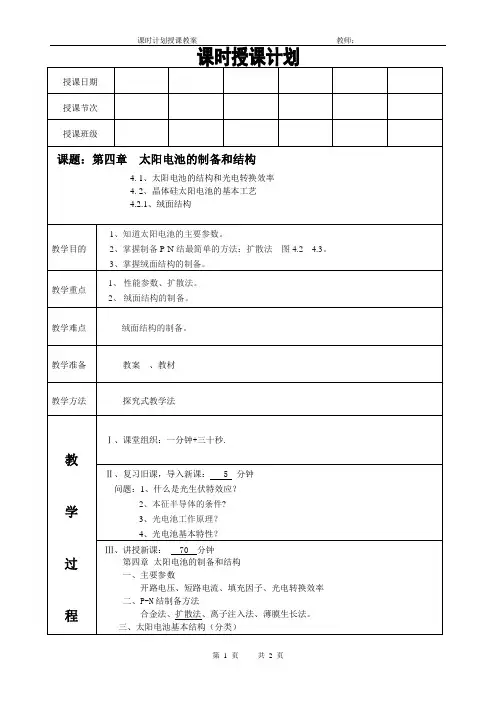
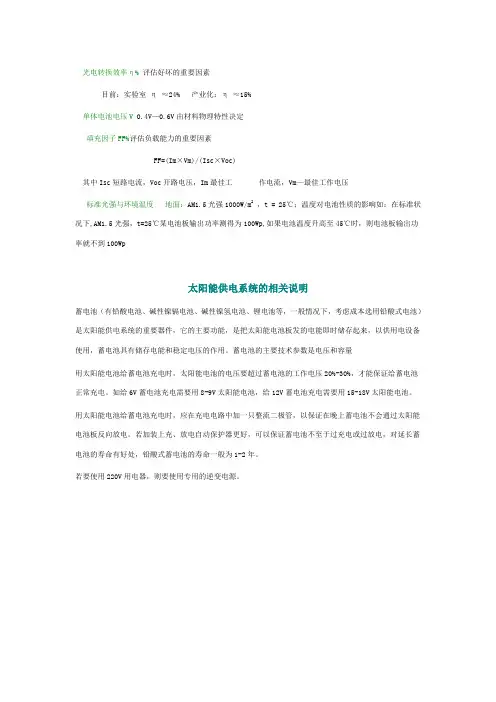
光电转换效率η% 评估好坏的重要因素
目前:实验室η≈24% 产业化:η≈15%
单体电池电压V 0.4V—0.6V由材料物理特性决定
填充因子FF%评估负载能力的重要因素
FF=(Im×Vm)/(Isc×Voc)
其中Isc短路电流,Voc开路电压,Im最佳工作电流,Vm—最佳工作电压
标准光强与环境温度地面:AM1.5光强1000W/m2,t = 25℃;温度对电池性质的影响如:在标准状况下,AM1.5光强,t=25℃某电池板输出功率测得为100Wp,如果电池温度升高至45℃时,则电池板输出功率就不到100Wp
太阳能供电系统的相关说明
蓄电池(有铅酸电池、碱性镍镉电池、碱性镍氢电池、锂电池等,一般情况下,考虑成本选用铅酸式电池)是太阳能供电系统的重要器件,它的主要功能,是把太阳能电池板发的电能即时储存起来,以供用电设备使用,蓄电池具有储存电能和稳定电压的作用。
蓄电池的主要技术参数是电压和容量
用太阳能电池给蓄电池充电时,太阳能电池的电压要超过蓄电池的工作电压20%-30%,才能保证给蓄电池正常充电。
如给6V蓄电池充电需要用8-9V太阳能电池,给12V蓄电池充电需要用15-18V太阳能电池。
用太阳能电池给蓄电池充电时,应在充电电路中加一只整流二极管,以保证在晚上蓄电池不会通过太阳能电池板反向放电。
若加装上充、放电自动保护器更好,可以保证蓄电池不至于过充电或过放电,对延长蓄电池的寿命有好处,铅酸式蓄电池的寿命一般为1-2年。
若要使用220V用电器,则要使用专用的逆变电源。
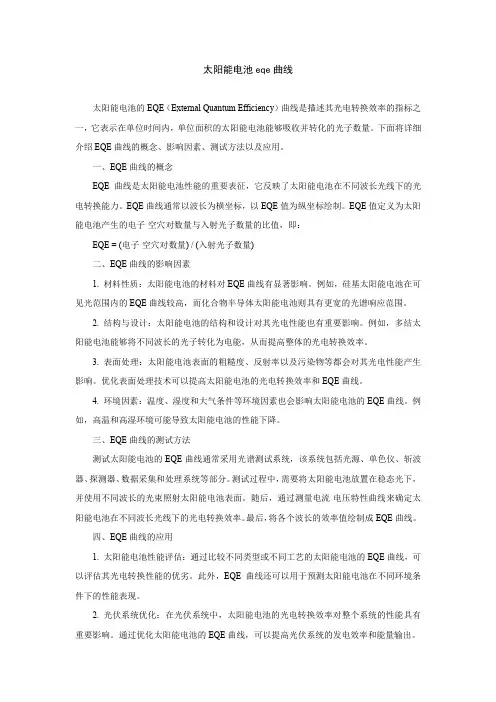
太阳能电池eqe曲线太阳能电池的EQE(External Quantum Efficiency)曲线是描述其光电转换效率的指标之一,它表示在单位时间内,单位面积的太阳能电池能够吸收并转化的光子数量。
下面将详细介绍EQE曲线的概念、影响因素、测试方法以及应用。
一、EQE曲线的概念EQE曲线是太阳能电池性能的重要表征,它反映了太阳能电池在不同波长光线下的光电转换能力。
EQE曲线通常以波长为横坐标,以EQE值为纵坐标绘制。
EQE值定义为太阳能电池产生的电子-空穴对数量与入射光子数量的比值,即:EQE = (电子-空穴对数量) / (入射光子数量)二、EQE曲线的影响因素1. 材料性质:太阳能电池的材料对EQE曲线有显著影响。
例如,硅基太阳能电池在可见光范围内的EQE曲线较高,而化合物半导体太阳能电池则具有更宽的光谱响应范围。
2. 结构与设计:太阳能电池的结构和设计对其光电性能也有重要影响。
例如,多结太阳能电池能够将不同波长的光子转化为电能,从而提高整体的光电转换效率。
3. 表面处理:太阳能电池表面的粗糙度、反射率以及污染物等都会对其光电性能产生影响。
优化表面处理技术可以提高太阳能电池的光电转换效率和EQE曲线。
4. 环境因素:温度、湿度和大气条件等环境因素也会影响太阳能电池的EQE曲线。
例如,高温和高湿环境可能导致太阳能电池的性能下降。
三、EQE曲线的测试方法测试太阳能电池的EQE曲线通常采用光谱测试系统,该系统包括光源、单色仪、斩波器、探测器、数据采集和处理系统等部分。
测试过程中,需要将太阳能电池放置在稳态光下,并使用不同波长的光束照射太阳能电池表面。
随后,通过测量电流-电压特性曲线来确定太阳能电池在不同波长光线下的光电转换效率。
最后,将各个波长的效率值绘制成EQE曲线。
四、EQE曲线的应用1. 太阳能电池性能评估:通过比较不同类型或不同工艺的太阳能电池的EQE曲线,可以评估其光电转换性能的优劣。
此外,EQE曲线还可以用于预测太阳能电池在不同环境条件下的性能表现。
电池板转换率怎么计算公式电池板转换率的计算公式。
在太阳能发电系统中,电池板的转换率是一个非常重要的指标,它反映了光能转化为电能的效率。
电池板转换率的计算公式可以帮助我们评估太阳能发电系统的性能,进而指导我们选择合适的电池板和优化系统设计。
电池板转换率(η)通常定义为光能转化为电能的比例,即输出电能与输入光能的比值。
其计算公式如下:η = (Pout / Pin) 100%。
其中,η为电池板转换率,Pout为电池板输出的电能,Pin为电池板输入的光能。
转换率通常以百分比的形式表示。
在实际应用中,电池板的输出电能可以通过电流和电压来计算,而输入光能则可以通过太阳辐射强度和电池板的面积来计算。
因此,电池板转换率的计算实际上涉及到多个参数的测量和计算,需要进行一定的实验和数据处理。
电池板转换率的影响因素。
影响电池板转换率的因素有很多,主要包括电池板的材料、结构、工作温度、光照条件等。
下面我们来分别介绍这些因素对电池板转换率的影响。
1. 材料,电池板的材料是影响转换率的关键因素之一。
目前主流的太阳能电池板材料有单晶硅、多晶硅、非晶硅、铟镓镉等。
不同材料的电池板具有不同的光电转换效率,其中单晶硅电池板的转换率通常较高。
2. 结构,电池板的结构设计也会影响其转换率。
例如,电池板的反射层、透明导电层、光捕捉结构等都会影响光的吸收和电子的传输效率,进而影响转换率。
3. 工作温度,温度对电池板的性能有很大影响,一般来说,电池板的工作温度越低,转换率越高。
因此,在实际应用中,需要考虑电池板的散热设计,以保持其在较低温度下工作。
4. 光照条件,光照条件是影响电池板转换率的重要因素。
光照强度越大,电池板的转换率通常越高。
因此,电池板的安装位置和角度需要合理设计,以充分利用光能资源。
电池板转换率的提高方法。
为了提高电池板的转换率,可以采取一系列措施,包括优化材料、结构设计、工作温度控制、光照条件优化等。
下面我们来介绍一些常见的提高电池板转换率的方法。
光电转换效率提高技术的研究与应用随着全球能源危机的加剧以及环境问题的日益严峻,人们开始寻求更为环保和高效的能源。
而太阳能作为最为广泛的可再生能源之一,在过去几年中快速发展,吸引了越来越多的关注和投资。
太阳能通过光电转换,将太阳能转化为电能,在人们的日常生活中有许多的应用,例如自动化设备、消防防盗等。
光电转换效率作为评价太阳能电池性能的重要指标,因此其提高技术的研究和应用也成为了目前太阳能发电领域的热点问题之一。
一、光电转换效率的意义与现状光电转换效率指的是光能被电池吸收后转化为电能的能力,也就是单个电池可以输出的最大功率。
提高光电转换效率可以使太阳能电池的功率增加,从而使其产生的能量更多。
因此,光电转换效率的提高对于太阳能发电的效益至关重要。
当前,太阳能光电转换效率普遍较低,大多数太阳能电池的转换效率不到20%。
单晶硅太阳能电池的效率约为17%-20%,多晶硅太阳能电池的效率一般在15%左右,铜铟镓硫 (CIS) 太阳能电池的效率约为13%-14%。
这也就说明,目前太阳能光电转换效率仍然有很大的提升空间。
二、提高光电转换效率的技术1、单晶硅技术:单晶硅太阳能电池在工艺方面最为成熟。
采用单晶硅锭,在高温下制成单晶硅片,然后经过多道工序形成太阳能电池。
虽然单晶硅技术具有技术条件稳定、工艺可控性强、可重复性好等优势,但其生产成本较高,仍有着一定的提高空间。
2、多晶硅技术:多晶硅太阳能电池使用的是多晶硅块在1500℃左右熔化成一块硅铸锭,之后被切成厚度为180微米的硅片,再加工成光伏电池。
多晶硅技术工艺稳定,生产成本相对于单晶硅是较低的,但其光电转换效率相对较低。
3、薄膜太阳能电池技术:薄膜太阳能电池是将薄膜材料制成电池,工艺特点是制造技术成熟、成本低,不需要高温、高压的过程,可以制造若干种形状和大小的电池。
其中,铜铟镓硫太阳能电池是其中比较有潜力的一种薄膜电池,近年来其光电转换效率不断提高。
4、混合极化层技术: 科学家们发现,将混合极化层引入太阳能电池的结构中能够提高电池的光电转换效率。
太阳能电池板原理及效率----bb897cc0-715a-11ec-ad99-7cb59b590d7d太阳能相信没有人会陌生,太阳能是一种可以运用而且相当庞大的能量,于是在科技发达的现在科学家们发明了太阳能电池板,一种通过吸收太阳光从而转化为电能的装置。
太阳能电池板是通过吸收太阳光,将太阳辐射能通过光电效应或者光化学效应直接或间接转换成电能的装置,大部分太阳能电池板的主要材料为“硅”,但专家说因制作成本很大,以致于它还不能被大量广泛和普遍地使用。
太阳能:太阳是一种巨大的能源。
它以每秒光辐射的形式向太空发射大约3.8倍的能量,10兆焦耳的能量中22亿分之一被投射到地球上。
阳光被大气反射和吸收后,70%的阳光被传输到地面。
然而,地球一年所接收的太阳能量仍然高达1.8×10^18kw•h中国电器交易网相信大家都知道自地球形成生物就主要以太阳提供的热和光生存,而自古人类也懂得以阳光晒干物件,并作为保存食物的方法,如制盐和晒咸鱼等。
但在化石燃料减少下,才有意把太阳能进一步发展。
专家向中国电器交易网介绍太阳能的利用有被动式利用(光热转换)和光电转换两种方式。
太阳能发电一种新兴的可再生能源。
广义上的太阳能是地球上许多能量的来源,如风能,化学能,水的势能等等。
太阳能发电原理太阳电池是一种对光有响应并能将光能转换成电力的器件。
能产生光伏效应的材料有许多种,据中国电器交易网调查就有如:单晶硅,多晶硅,非晶硅,砷化镓,硒铟铜等。
它们的发电原理基本相同,现以晶体硅为例描述光发电过程。
p型晶体硅经过掺杂磷可得n型硅,形成p-n结。
当光线照射太阳电池表面时,一部分光子被硅材料吸收;光子的能量传递给了硅原子,使电子发生了跃迁,成为自由电子在p-n结两侧集聚形成了电位差,当外部接通电路时,在该电压的作用下,将会有电流流过外部电路产生一定的输出功率。
这个过程的的实质是:光子能量转换成电能的过程。
我相信每个人都会认为太阳能是直接从光到电的。
太阳能板的转换效率太阳能板的转换效率是决定太阳能电池技术成败的重要因素之一。
现代的太阳能电池一般采用硅晶体材料,经过一系列的工艺制造成太阳能电池板。
太阳能板的转换效率与电池结构和材料制备工艺等因素密切相关,以下是太阳能板转换效率的相关介绍:一、太阳能板转换效率的定义太阳能板的转换效率指的是太阳光能转化为电能的效率,即单位面积太阳辐射下所产生的最大功率与太阳辐射总功率的比值,用百分比表示。
太阳能电池板的转换效率越高,其产生的电能也就越多。
二、太阳能板转换效率的影响因素1. 材料的品质:太阳能电池板的转换效率与材料的性能密切相关。
现代太阳能电池板一般采用高纯度的硅材料制成,提高太阳能电池板的纯度,可以提高电池板的转换效率。
2. 电极的设计:太阳能电池板的电极在转换效率方面也起着决定性作用。
优秀的电极设计可提高电池的电荷传递效率,进而提高电池的转换效率。
3. 导电材料的选用:导电材料对太阳能电池的转换效率也有重要影响。
一些高电导率的材料,如银、铜等,可以提高电池的转换效率。
4. 电池的结构:太阳能电池板的结构也影响转换效率,目前广泛使用的结构有单晶、多晶和非晶。
其中单晶结构转换效率最高,但成本较高,多晶和非晶结构虽然转换效率低一些,但成本相对较低。
三、太阳能板转换效率的测试方法目前,常用的太阳能电池板转换效率测试方法有三种:AM0、AM1.5和AM2。
其中AM1.5是最常用的测试方法,它模拟了太阳辐射在地球上的平均光谱分布。
AM1.5测试方法下,目前已经开发出许多测量太阳能电池板转换效率的设备。
这些设备一般采用光电二极管或光电二极管阵列,将太阳辐射能转化成电信号进行测试,从而得到电池板的转换效率值。
总的来说,太阳能板的转换效率是衡量太阳能电池板性能的重要参数之一。
未来,随着太阳能技术的不断发展和创新,太阳能电池板的转换效率将会有大幅度提高,推动太阳能产业的快速发展。
太阳能光电转换技术的研究进展太阳能是一种干净、绿色的可再生能源,拥有无限的潜力。
太阳能光电转换技术是利用太阳能光线转换为电能的一种方式,近年来一直受到科学家们的关注和投入。
本文将从太阳能光电转换技术的原理、现状、应用和未来等多方面进行分析和探讨。
一、太阳能光电转换技术的原理太阳能光电转换技术是将光能转换为电能的一种技术。
其原理主要是通过半导体材料吸收光子,使电子受到光子能量的激发导致电荷分离并产生电流。
半导体材料一般使用的是硅(Si)或多元化合物半导体(如硒化铜铟镓、硫化镉等)。
太阳能光电转换技术涉及的主要过程是光致电子激发、电荷分离和电流收集。
其中,光致电子激发是指太阳光线中的光子被吸收,并被半导体中的电子吸收形成激发态,激发态的电子和半导体价带中的电子相互结合形成电荷分离,电荷分离过程是太阳能光电转换的关键。
二、太阳能光电转换技术的现状太阳能光电转换技术自20世纪50年代以来便被广泛研究和应用。
近年来,借助于科技进步,太阳能光电转换技术已经取得了可喜的进展。
目前,太阳能电池技术主要包括晶体硅太阳能电池、非晶硅太阳能电池、有机太阳能电池、钙钛矿太阳能电池等多种类型。
其中最常见的是晶体硅太阳能电池,在实际应用中已经得到广泛推广。
晶体硅太阳能电池主要采用单晶硅或多晶硅制成,工作原理基于p-n结的特性,光照在p-n结上会产生光电效应,使得电子从价带经过p-n结进入n区,并在电场的作用下流向p区,形成电流。
随着太阳能光电转换技术的不断发展,钙钛矿太阳能电池日渐兴起。
钙钛矿太阳能电池采用钙钛矿材料作为基底,通过与有机材料复合来增强光电转换效果。
钙钛矿太阳能电池的转换效率较高,且制造成本低,具有广阔的应用前景。
除了上述两种主流太阳能电池技术,非晶硅太阳能电池、有机太阳能电池等技术也在不断探索和研究中。
这些新型太阳能电池不仅能够改善电池性能,同时对于环境影响也较小,有望成为太阳能光电转换技术的未来发展方向。
SHORTCOMMUNICATIONResearchSolarCellEfficiencyTables(Version34)
MartinA.Green1*,y,KeithEmery2,YoshihiroHishikawa3andWilhelmWarta41ARCPhotovoltaicsCentreofExcellence,UniversityofNewSouthWales,Sydney,2052,Australia
2NationalRenewableEnergyLaboratory,1617ColeBoulevard,Golden,CO.,80401,USA
3NationalInstituteofAdvancedIndustrialScienceandTechnology(AIST),ResearchCenterforPhotovoltaics(RCPV),Central2,Umezono1-1-1,Tsukuba,
Ibaraki,305-8568,Japan4Fraunhofer-InstituteforSolarEnergySystems,Department:SolarCells—MaterialsandTechnology,Heidenhofstr.2;D-79110Freiburg,Germany
Consolidatedtablesshowinganextensivelistingofthehighestindependentlyconfirmedefficienciesforsolarcellsandmodulesarepresented.GuidelinesforinclusionofresultsintothesetablesareoutlinedandnewentriessinceJanuary,2009arereviewed.Copyright#2009JohnWiley&Sons,Ltd.
keywords:solarcellefficiency;photovoltaicefficiency;energyconversionefficiencyReceived7May2009
INTRODUCTIONSinceJanuary1993,‘ProgressinPhotovoltaics’haspublishedsixmonthlylistingsofthehighestconfirmedefficienciesforarangeofphotovoltaiccellandmoduletechnologies.1,2Byprovidingguidelinesfortheinclu-sionofresultsintothesetables,thisnotonlyprovidesanauthoritativesummaryofthecurrentstateoftheartbutalsoencouragesresearcherstoseekindependentconfirmationofresultsandtoreportresultsonastandardisedbasis.InthepreviousversionoftheseTables(Version33)2,resultswereupdatedtothenewinternationallyacceptedreferencespectrum(IEC60904-3,Ed.2,2008),wherethiswaspossible.Themostimportantcriterionforinclusionofresultsintothetablesisthattheymusthavebeenmeasuredbyarecognisedtestcentrelistedelsewhere.2Adistinctionismadebetweenthreedifferenteligibleareas:totalarea;apertureareaanddesignatedilluminationarea1.‘Activearea’efficienciesarenotincluded.Therearealsocertainminimumvaluesoftheareasoughtforthedifferentdevicetypes(above0Á05cm2foraconcen-tratorcell,1cm2foraone-suncell,and800cm2foramodule)1.Resultsarereportedforcellsandmodulesmadefromdifferentsemiconductorsandforsub-categorieswithineachsemiconductorgrouping(e.g.crystalline,polycrystallineandthinfilm).
NEWRESULTSHighestconfirmedcellandmoduleresultsarereportedinTablesI,IIandIV.Anychangesinthetablesfromthosepreviouslypublished2aresetinboldtype.Inmostcases,aliteraturereferenceisprovidedthatdescribeseithertheresultreportedorasimilarresult.TableIsummarisesthebestmeasurementsforcellsandsubmodules,TableIIshowsthebestresultsformodulesandTableIVshowsthebestresultsforconcentratorcellsandconcentratormodules.TableIIIcontainswhatmightbedescribedas‘notableexcep-tions’.Whilenotconformingtotherequirementstoberecognisedasaclassrecord,thecellsandmodulesinthisTablehavenotablecharacteristicsthatwillbeofinteresttosectionsofthephotovoltaiccommunitywithentriesbasedontheirsignificanceandtimeliness.
PROGRESSINPHOTOVOLTAICS:RESEARCHANDAPPLICATIONSProg.Photovolt:Res.Appl.2009;17:320–326PublishedonlineinWileyInterScience(www.interscience.wiley.com)DOI:10.1002/pip.911
*Correspondenceto:MartinA.Green,ARCPhotovoltaicsCentreofExcellence,UniversityofNewSouthWales,Sydney,2052,Aus-tralia.yE-mail:m.green@unsw.edu.au
Copyright#2009JohnWiley&Sons,Ltd.Toensurediscrimination,TableIIIislimitedtonominally10entrieswiththepresentauthorshavingvotedfortheirpreferencesforinclusion.ReaderswhohavesuggestionsofresultsforinclusionintothisTablearewelcometocontactanyoftheauthorswithfulldetails.Suggestionsconformingtotheguidelineswillbeincludedonthevotinglistforafutureissue(asmallernumberof‘notableexceptions’forconcen-tratorcellsandmodulesadditionallyisincludedinTableIV).SevennewresultsarereportedinthepresentversionoftheseTables.ThefirstnewresultinTableIistheachievementof8Á4%efficiencyreferencedtothenewspectrumfora17cm2dye-sensitisedsubmodulefabricatedbySony3
andmeasuredbytheJapaneseNationalInstituteofAdvancedIndustrialScienceandTechnology(AIST).AnothernewresultinTableIisimprovementintheefficiencyto2Á05%foranorganicphotovoltaicsub-module(223Á5cm2inarea)fabricatedbyPlextronics,
TableI.ConfirmedterrestrialcellandsubmoduleefficienciesmeasuredundertheglobalAM1Á5spectrum(1000W/m2)at258C(IEC60904-3:2008,ASTMG-173-03global)
ClassificationaEfficb(%)Areac(cm2)Voc(V)Jsc(mA/cm2)FFd(%)Testcentree(anddate)Description
SiliconSi(crystalline)25Á0Æ0Á54Á00(da)0Á70642Á782Á8Sandia(3/99)fUNSWPERL11
Si(multicrystalline)20Á4Æ0Á51Á002(ap)0Á66438Á080Á9NREL(5/04)fFhG-ISE12Si(thinfilmtransfer)16Á7Æ0Á44Á017(ap)0Á64533Á078Á2FhG-ISE(7/01)fU.Stuttgart(45mmthick)13Si(thinfilmsubmodule)10Á5Æ0Á394Á0(ap)0Á492g29Á7g72Á1FhG-ISE(8/07)fCSGSolar(1–2mmonglass;20cells)14